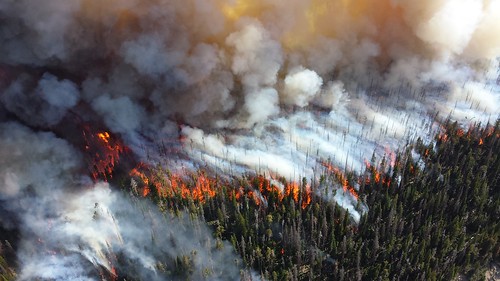美國智庫「科學工作者關懷聯盟」(Union of Concerned Scientists,UCS)10日發表新研究,援引美國林務署的預測數據提出警告,氣候變遷可能減損90%的洛磯山脈森林。
天乾物燥 暖化延長野火季節
這篇名為「洛磯山森林危機」(Rocky Mountain Forests at Risk)的報告指出,極熱和乾旱氣候、越來越長的野火季節、越來越大的火勢以及甲蟲害,過去15年來殺死數以千萬計的的洛磯山樹木。
研究共同作者、洛磯山氣候組織總裁Stephen Saunders指出,根據美國林務署的預測,未來氣候適宜顫楊、白皮松和矮松生存的面積將減少58%到90%。
白楊是唯一廣泛分布於洛磯山的樹種,林務署預測到了2060年將減少61%。某些地區白楊類會增加,但大部分地區都會減少,蒙大拿州減少達71%,科羅拉多達41%。
原始林未見復生 洛磯山林貌恐變
1980年代起,洛磯山森林大火發生次數增加了73%,每年增加18次。從1987年到2003年間森林大火每年燒掉的面積是1970到1986年間的6倍。全洛磯山原始森林樹木死亡率變成兩倍,但樹苗卻沒有等量的增加。科學家認為很可能是環境變得更乾熱所造成。
科學家警告,如果氣候變遷持續不受控制,這些現象將會在接下來幾年惡化,減少象徵性樹種的生存範圍,並徹底改變洛磯山森林的樣貌。
科學家說這些預測並非完全準確,但Saunders說,如果讓氣候變遷繼續照目前的速度持續下去,可能讓洛磯山大量失去森林。
另一位共同作者、科學工作者關懷聯盟資深科學家Jason Funk博士說,就算能立即減碳,暖化現象仍會持續。目前觀察到的森林現象,是僅暖化華氏2度的結果。
Climate change could kill up to 90 percent of the forests covering the Rocky Mountains, warned the nonprofit Union of Concerned Scientists today in a new study based in part on projections made by the U.S. Forest Service.
Extreme heat and drought, more and larger wildfires over a longer fire season, and beetle infestations have killed tens of millions of trees in the Rocky Mountains over the past 15 years, according to the study, “Rocky Mountain Forests at Risk.”
If climate change is allowed to continued unchecked, the scientists warn, these impacts will increase in the years ahead, reducing the ranges of iconic tree species, and fundamentally alter the Rocky Mountain forests that we know today.
Stephen Saunders, report co-author and president of the Rocky Mountain Climate Organization, told reporters on a conference call today that the U.S. Forest Service has made projections of future climactic suitability for three tree species – Quaking aspens, Whitebark pines and Piñon pines.
“Reductions of 58 percent to 90 percent in areas climactically suitable for these species in the future,” said Saunders.
For aspens, the Rockies’ only widespread deciduous tree species, the Forest Service projects an overall decline of 61 percent by the year 2060. There will be increases in some places, said Saunders, but in most places the decrease will be much greater – a 71 percent decline in Montana, and a 41 percent in Colorado.
The scientists say these are not firm projections, but, Saunders said, “If we keep changing the climate the way we are, we could be changing the forests of the Rocky Mountains with much reduced forest cover.”
Dr. Jason Funk, report co-author and senior climate scientist with the Union of Concerned Scientists, acknowledged to ENS, “We will see some warming continue even if we put the brake on emissions immediately.”
The changes we have seen so far have been driven by just 2 degrees Fahrenheit of global warming, he said.
Since the 1980s, the number of large wildfires in the Rocky Mountains has risen by 73 percent, or about 18 more large wildfires each year. Wildfires burned more than six times as much land each year on average from 1987 to 2003 compared to the period from 1970 to 1986.
The mortality rate of trees has doubled in old-growth, undisturbed forests throughout the Rockies, with no compensating increase in the number of seedlings. Scientists suggest that hotter and drier conditions are likely responsible.
※ 全文及圖片詳見:ENS








